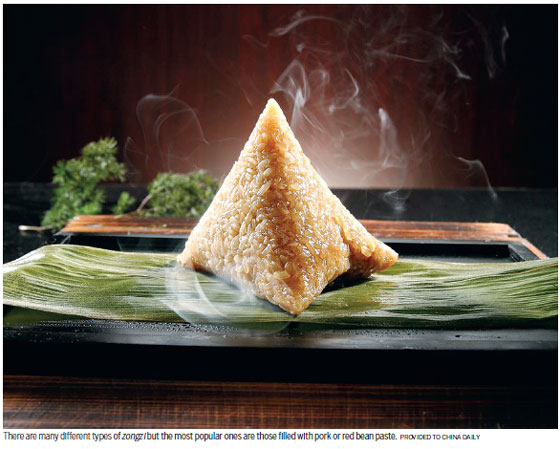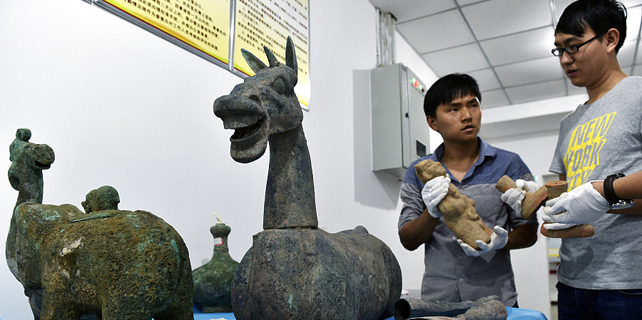In Search Of A Robotic Helping Hand

There have been a dozen emails and phone calls by various enquirers since Wufangzhai posted the notice. Six parties, including an American research institute, have already paid a visit to the company's manufacturing facility in an attempt to understand the challenges involved.
But no one has managed to create or even suggest a prototype yet, according to the company.
"We have been devoted to industrializing the craft of making rice dumplings for decades. The process of wrapping the dumplings is the final barrier we have yet to overcome," said He Jianfei, director of Wufangzhai Research Center.
He is also a food scientist who joined the company a decade ago to aid its efforts of speeding up the dumpling-making process.
Founded in 1921 as an unassuming neighborhood shop, Wufangzhai is now China's largest producer of rice dumplings, accounting for half of the dumplings sold across the country. It is expected to make 350 million dumplings this year, an increase of 10 percent from 2016. The company believes that it can sell as many dumplings as it makes.
"There are 1.3 billion people in the country. We haven't been able to feed every Chinese because of our limited capacity," said He.
With three manufacturing bases in the country, Wufangzhai employs around 1,000 workers to wrap dumplings. During the peak season every year, which runs from March to June, each worker makes an average of 2,000 to 3,000 dumplings every day.
"The peak in demand lasts only a few months. It is therefore inefficient to employ so many workers all year round only to have them work for just a quarter of the time. By introducing mechanical hands into the process, we can greatly improve our productivity," said Hu, who is now the chief technology officer of Wufangzhai.
Like many State-owned companies in China, Wufangzhai underwent radical reforms in the early 1990s when the country reopened its doors to the world and welcomed private capital. It was bought over as a private company in 1995 before it started to introduce technology into its manufacturing process.
In 2009, the company expanded its fast food chain all over the country with an ambition to make rice dumplings "the Chinese hamburger". The company has 410 fast food outlets as of the end of 2016.
Over the past decade, Wufangzhai has worked with a Japanese company to develop a system to wash, filter and steam the glutinous rice used in the dumplings. The company also utilizes a specially created device to count the number of dumplings made per day. Wufangzhai makes an average of 1.3 million dumplings daily.
He said that one of the key challenges is that most of the ingredients used are impossible to be standardized in terms of weight and size. As such, it is difficult for a robotic hand to determine how much rice or stuffing is required.
Wufangzhai's attempt to embrace automation has been met with mixed reactions. Many have argued that machines should not be used to replace human beings in the workforce.
However, the company has claimed that it does not plan on letting go of its workers, saying that the machines are merely a means to boost production volume instead of reducing labor cost. Wufangzhai also said it is looking to introduce niche dumpling types that can only be made by human hands.
"It is irrational to just stick to the old ways simply for the sake of preserving them. We wouldn't have enough food or clothes, or even an automobile to travel around, if we were to rely on just our hands," said Hu.
The idea of championing craftsmanship was officially put forward in March 2016, by Chinese Premier Li Keqiang during the annual meeting of the nation's legislators and political advisers.
As a growing number of Chinese are favoring foreign products such as formulated baby milk powder, cosmetics and toilet lids, it is believed that made-in-China products could stay competitive by being rooted in the nation's rich history of craftsmanship.
The call to embrace craftsmanship has since created a nationwide surge in interest, which has in turn resulted in burgeoning sales of handmade Chinese products. The movement has also inspired many, especially those from the younger generation, to appreciate the beauty of craftsmanship, which revolves around determination, patience and the devotion to the pursuit of perfection.
But Hu and He shared a different definition of craftsmanship.
"There are multiple ways to pay homage to craftsmanship. Freeing craftsmen from repetitive and laborious work and having their skills devoted to more valuable jobs could be one," said Hu.
"Besides, I would readily savor a machine-made dumpling as long as the taste remains the same."
xujunqian@chinadaily.com.cn
















